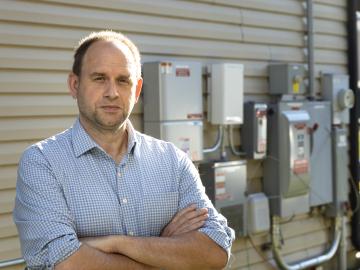
Filter News
Area of Research
- (-) Energy Science (102)
- Advanced Manufacturing (1)
- Biology and Environment (69)
- Building Technologies (1)
- Computational Biology (1)
- Computational Engineering (3)
- Computer Science (13)
- Energy Sciences (1)
- Fusion and Fission (6)
- Fusion Energy (2)
- Isotopes (20)
- Materials (48)
- Materials for Computing (6)
- Mathematics (1)
- National Security (21)
- Neutron Science (20)
- Nuclear Science and Technology (5)
- Quantum information Science (4)
- Supercomputing (59)
- Transportation Systems (1)
News Type
News Topics
- (-) Biology (8)
- (-) Biomedical (5)
- (-) Clean Water (6)
- (-) Computer Science (19)
- (-) Cybersecurity (5)
- (-) Energy Storage (57)
- (-) Isotopes (1)
- 3-D Printing/Advanced Manufacturing (62)
- Advanced Reactors (3)
- Artificial Intelligence (5)
- Big Data (3)
- Bioenergy (18)
- Biotechnology (3)
- Buildings (27)
- Chemical Sciences (11)
- Composites (14)
- Coronavirus (10)
- Critical Materials (9)
- Environment (34)
- Exascale Computing (2)
- Fossil Energy (1)
- Frontier (1)
- Fusion (1)
- Grid (29)
- High-Performance Computing (3)
- Hydropower (2)
- Machine Learning (6)
- Materials (31)
- Materials Science (21)
- Mathematics (2)
- Mercury (3)
- Microscopy (7)
- Molten Salt (1)
- Nanotechnology (6)
- National Security (5)
- Neutron Science (8)
- Nuclear Energy (5)
- Partnerships (8)
- Physics (1)
- Polymers (10)
- Quantum Science (1)
- Security (5)
- Simulation (2)
- Space Exploration (2)
- Statistics (1)
- Summit (3)
- Transportation (53)
Media Contacts

Oak Ridge National Laboratory researchers have developed a new family of cathodes with the potential to replace the costly cobalt-based cathodes typically found in today’s lithium-ion batteries that power electric vehicles and consumer electronics.

The annual Director's Awards recognized four individuals and teams including awards for leadership in quantum simulation development and application on high-performance computing platforms, and revolutionary advancements in the area of microbial

Four research teams from the Department of Energy’s Oak Ridge National Laboratory and their technologies have received 2020 R&D 100 Awards.

The combination of bioenergy with carbon capture and storage could cost-effectively sequester hundreds of millions of metric tons per year of carbon dioxide in the United States, making it a competitive solution for carbon management, according to a new analysis by ORNL scientists.

Joe Hagerman, ORNL research lead for buildings integration and controls, understands the impact building technology innovations can have during times of crisis. Over a decade ago, he found himself in the middle of one of the most devastating natural disasters of the century, Hurricane Katrina.

Five researchers at the Department of Energy’s Oak Ridge National Laboratory have been named ORNL Corporate Fellows in recognition of significant career accomplishments and continued leadership in their scientific fields.

Scientists at ORNL used neutron scattering and supercomputing to better understand how an organic solvent and water work together to break down plant biomass, creating a pathway to significantly improve the production of renewable

Oak Ridge National Laboratory scientists seeking the source of charge loss in lithium-ion batteries demonstrated that coupling a thin-film cathode with a solid electrolyte is a rapid way to determine the root cause.

Ada Sedova’s journey to Oak Ridge National Laboratory has taken her on the path from pre-med studies in college to an accelerated graduate career in mathematics and biophysics and now to the intersection of computational science and biology

Oak Ridge National Laboratory researchers have developed a thin film, highly conductive solid-state electrolyte made of a polymer and ceramic-based composite for lithium metal batteries.


